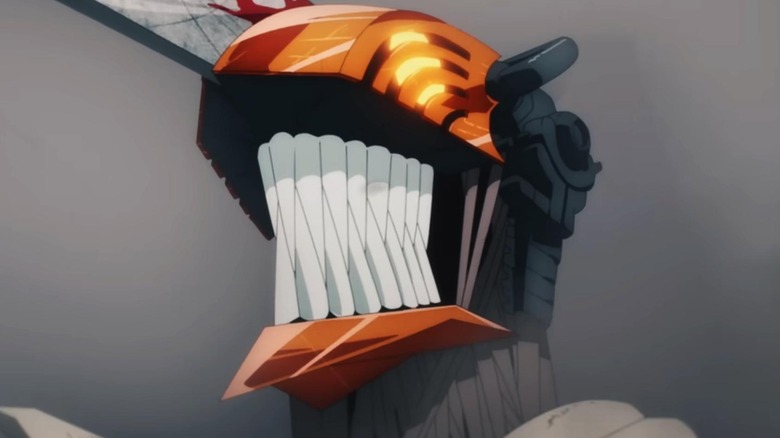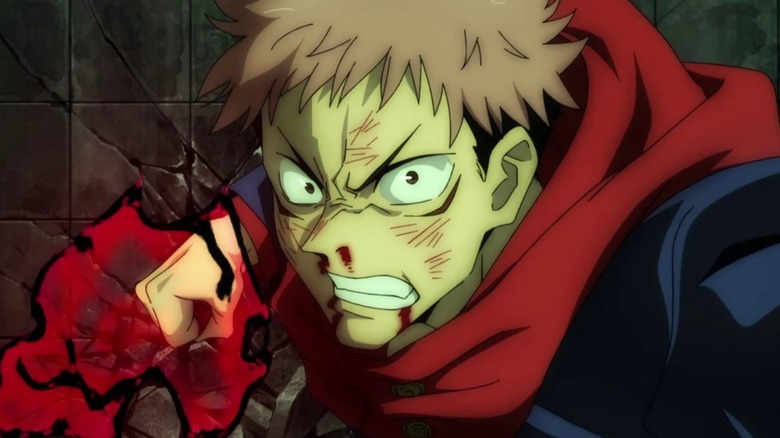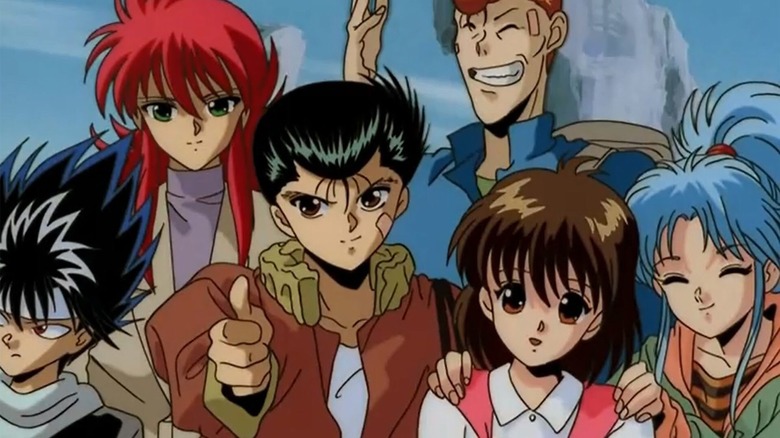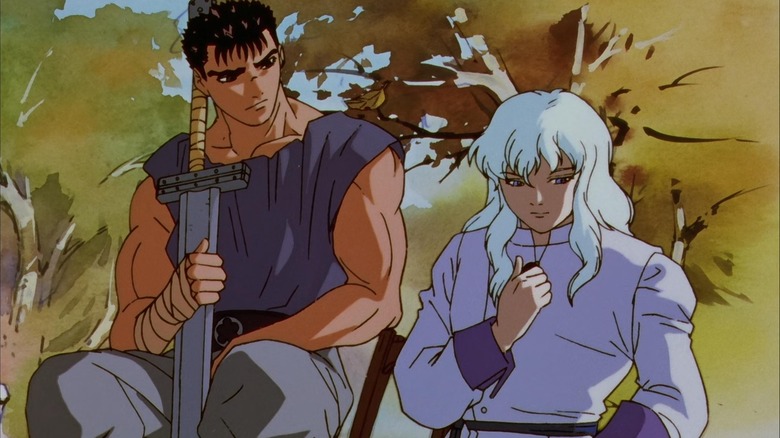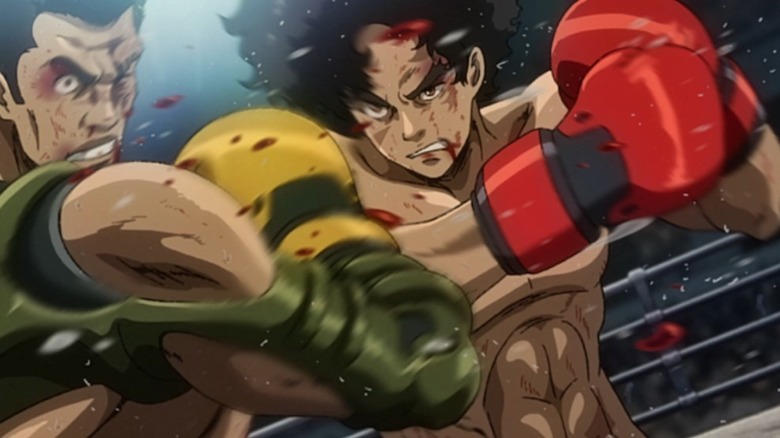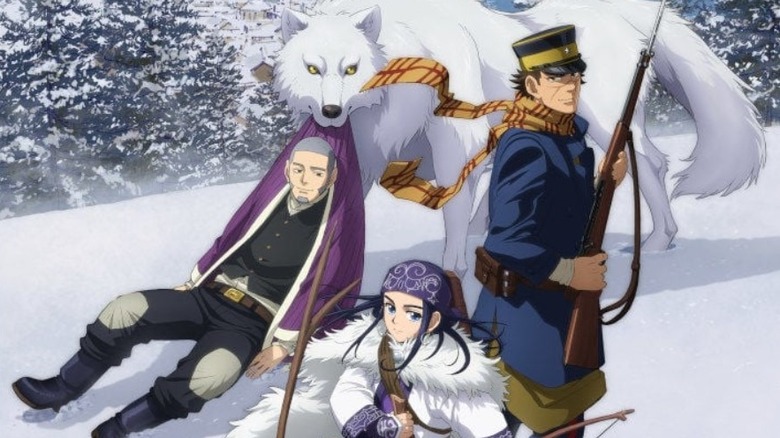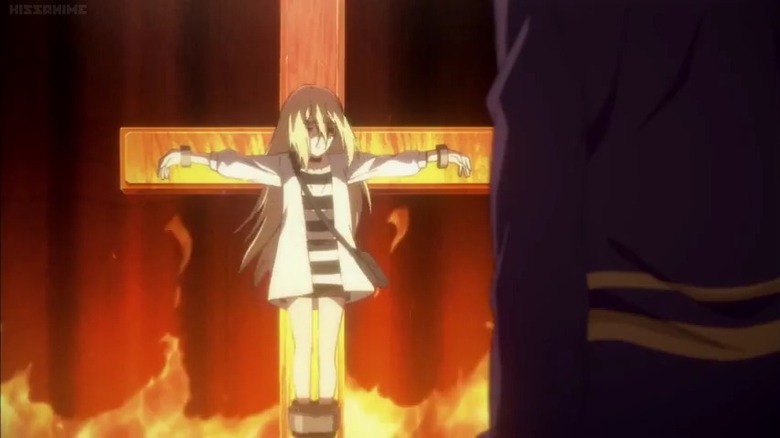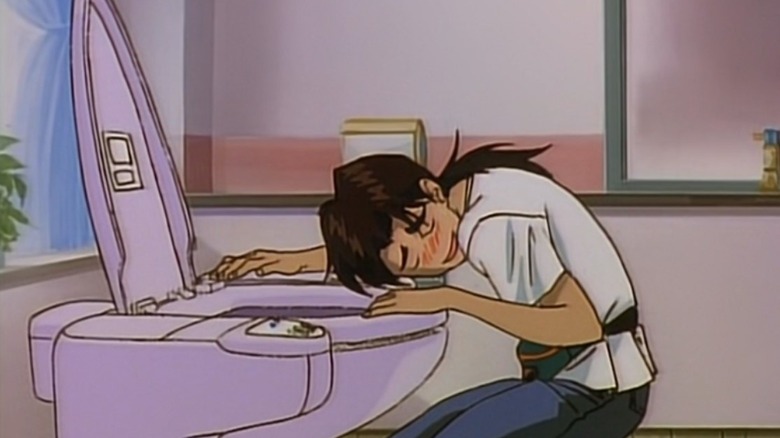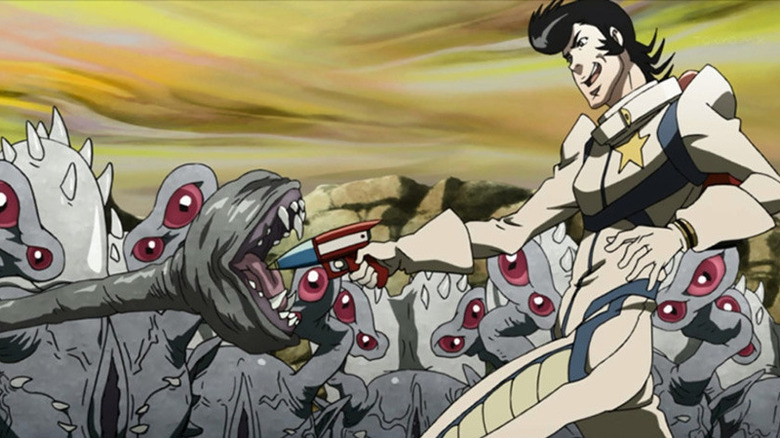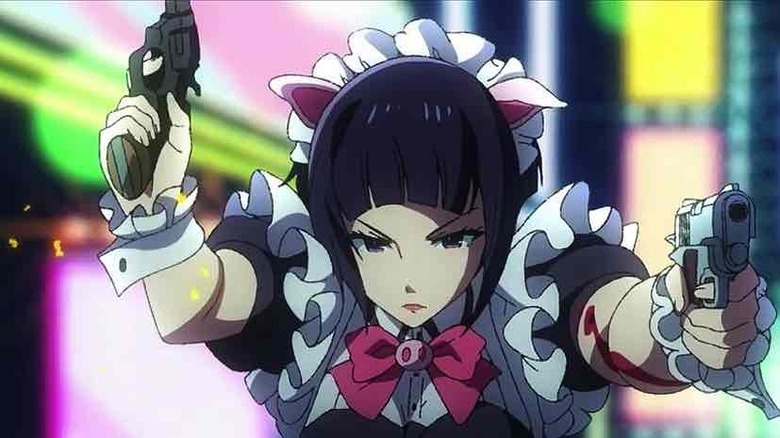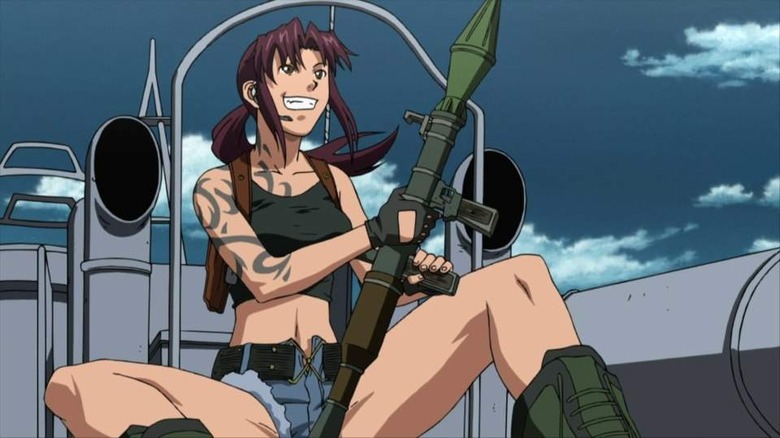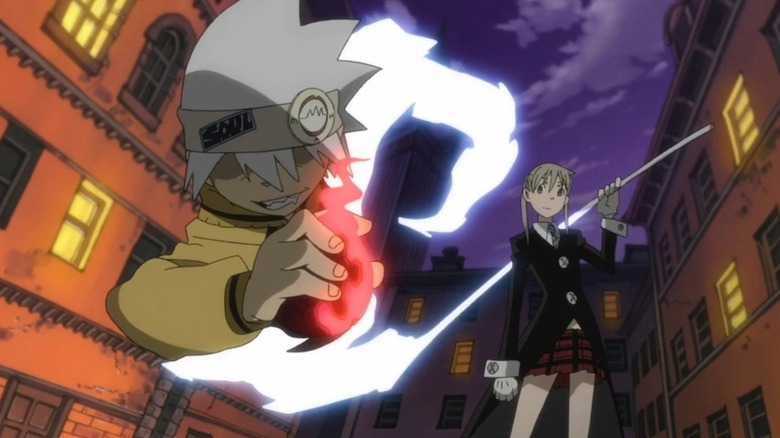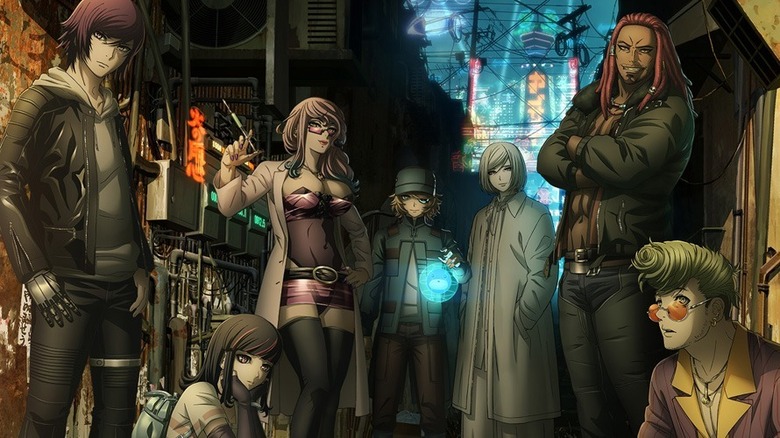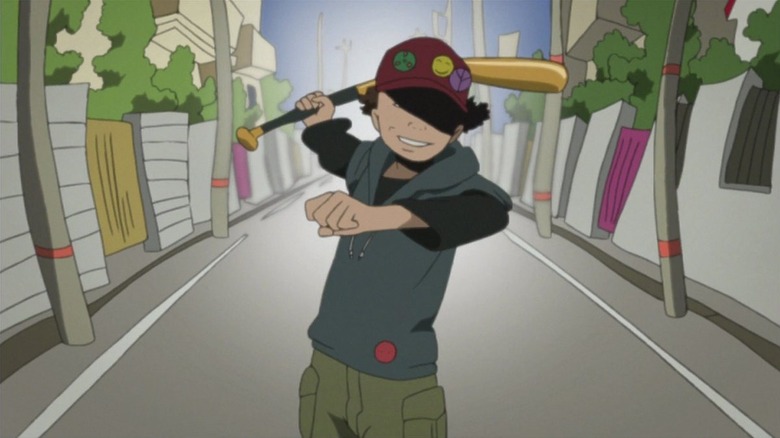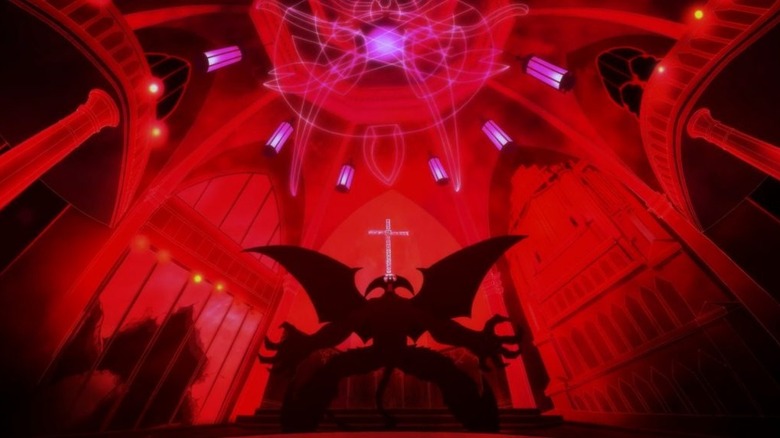14 Anime Series Like Chainsaw Man You Need To See
If you regularly follow anime at all, you've almost certainly seen something about "Chainsaw Man." Whether it's the 18 million copies of the manga in circulation, cosplayers in simple black suits, or viral art of cute chainsaw dogs, the series has been a runaway train of popularity since it debuted in December 2018.
"Chainsaw Man" follows Denji, a young man saddled with debt whose only friend is a tiny chainsaw-faced devil named Pochita. When Denji is marked more profitable dead than alive by his debtors, Pochita willingly becomes his new heart, and Denji is reborn as the human-devil hybrid Chainsaw Man. That makes him a valuable asset to the Public Safety Devil Hunters, who give Denji a choice: join them and help keep the populace safe from devils or be put down like one.
Now that the anime is finally here, new audiences are getting a chance to find out what all the hype's about. But with only 12 confirmed episodes so far, anime fans will likely have some time to fill once the show wraps up in December 2022. To help, we've put together a list of other anime series to try in the meantime across a variety of genres.
Jujutsu Kaisen
There's a good chance that if you're a fan of shounen anime, you've already heard of this one. "Jujutsu Kaisen 0," the feature film prequel to the mega-popular anime, made roughly $30 billion at the American box office alone. It's both currently running and the closest in premise to "Chainsaw Man," so it's a nice baby step for people looking to branch out. In "Jujutsu Kaisen," Yuji Itadori becomes the host of a powerful demon (here called a "Curse") when he swallows a cursed finger talisman to protect his friends. Since Yuji maintains his sense of self post-possession — scary voice in his head notwithstanding — he gets taken in for training by the sorcerers dispatched to kill him. If he can collect the other fingers, then his curse will supposedly be lifted.
"Jujutsu Kaisen" is a good fit for audiences who want a more openly kind-hearted protagonist and a warmer vibe between the main cast. "Chainsaw Man" is marked by a prickly fear and distrust of others, especially in its early going, but "Jujutsu Kaisen" leans a little more into the genre's traditional "power of friendship" camaraderie, which gives it a good sense of empathy when it decides to touch on the suffering that drives many of its characters.
Yu Yu Hakusho
Younger anime fans likely know Yoshihiro Togashi for "Hunter X Hunter," a series that faces frequent hiatuses because the punishing expectations put on manga artists ruined Togashi's health. But in the early '90s, "Yu Yu Hakusho" was his claim to fame, and it's held up better than most of its contemporaries over the last 30 years.
"Yu Yu Hakusho" begins with the death of its protagonist, Yusuke Urameshi, when he pushes a young child out of the way of a speeding car. Yusuke's delinquent life and unexpectedly heroic death leave him fit neither for paradise nor Hell, so instead he's offered the chance to take on tasks as a "spirit detective" in order to earn a second chance at life.
Denji owes a lot to the punk protagonists of the '80s and '90s, beaten down by a society that has nothing for them (like "Chainsaw Man," "Yu Yu Hakusho" started publishing during the fallout of major economic recession) who find comradery in unexpected places and often end up pitted against malevolent established power structures. It's probably the most direct, if slightly more young teen-appropriate analog to "Chainsaw Man" from a previous generation.
Berserk
It's difficult to overstate the importance of "Berserk," from its place as one of the best-selling manga of all time to its influence on other big-name creators like "Dark Souls" director Hidetaka Miyazaki. It begins with the story of a lone warrior, Guts, wandering a demon-infested hellscape on a mission to kill a man named Griffith. The story then flashes back to Guts as a young man, recruited by an idealistic Griffith into the Band of the Hawk. The beloved 1997 adaptation in particular is an agonizing tragedy.
"Berserk" is, not unlike "Chainsaw Man," the story of a group of deeply scarred misfits who grasp onto each other in an unforgiving world, and despite the initial growth and care they find together it isn't long before political machinations and plain hubris dissolve their found family. And while it has the trappings of fantasy, its most memorable moments are when it shades into horror. If you're looking for more memorably upsetting demon designs, this is not one to be missed.
Megalo Box
Want another anime about a protagonist beaten down by a bleak capitalist hellscape fighting for a life that would allow him a scrap of human dignity, but also there are cool action scenes? Like another title on this list, "Megalo Box" is actually a modern take on a classic franchise; in this case, the beloved boxing series "Tomorrow's Joe." While the late '60s manga loosely followed the structure of a talented newcomer working his way up the ladder, "Megalo Box" starts at a different kind of rock bottom.
Megalo boxing is similar to classic boxing, but the boxers are equipped with powered exoskeletons known as "Gears." It's a hugely popular sport in the Administrative Area, a glittering metropolis for those with registered citizenship. Those not considered citizens are banished to the slums of the Restricted Area, which is where a boxer known only as "Junk Dog" spends his days throwing fights at a shady underground boxing ring. Junk Dog's world is changed when he loses in a real match with Megalo Box champion Yuri and must work his way up the tournament rankings to face the man again. But without a backer or resources, Junk Dog takes on a different gimmick: facing his opponents with no Gear of his own.
While the first series is a thrilling sports series, the unexpected sequel takes the opportunity to dig deep into its themes of social inequality, pushing it from a creative reinterpretation of a classic to a remake that can truly justify being brought back for a modern audience.
Golden Kamuy
If only all action anime could be as bold and weird as "Golden Kamuy." The premise has echoes of "Treasure Island," as an enormous quantity of gold was amassed by a group of Ainu miners, one of whom killed the rest and hid it away. When he was captured, he tattooed pieces of a map on the skin of many of his fellow inmates, or so the tall tale goes. War veteran Saichi Sugimoto happens to uncover a piece of the map, and to find the treasure he teams up with a young Ainu girl named Asirpa, whose father was one of the murdered miners.
That alone is a great setup for an adventure story, but "Golden Kamuy" is more. It's set in early 1900s Hokkaido, and it's rare in prominently discussing the often overlooked and historically oppressed Indigenous Ainu people, such that activists have credited the series with helping to promote interest in Ainu culture overall. It's also funny as hell. Asirpa rivals beloved "Spy X Family" gremlin Anya for reaction-image-worthy faces, and the manga author has been known to do things like rank the main cast by their penis size.
Sometimes the anime is strained in the visual department — a particularly jarring CGI bear comes to mind — but if anything, that adds to the experience. It's a series that loves the weird and tongue-in-cheek, and then turns into scenes of nail-biting tension or discussions of torture without ever breaking eye contact. If the mashup of gore and unexpected tension-breaking jokes draws you to "Chainsaw Man," please give this series more love. The manga even finished in early 2022.
Angels of Death
Must an anime be good? Is it not enough for it to be grimdark and hilarious? "Angels of Death" is the little title that could, starting out as a freeware RPG Maker game and becoming so beloved that it grew into a polished paid release, several manga, a prequel, some novel adaptations, and an anime. Its plot will probably sound familiar to fans of indie horror, given that it involves an amnesiac protagonist having to puzzle her way through a mysterious building to remember memories she is certainly not repressing for guilt-related reasons. This is 13-year-old Rachel, who is joined in her exploration by Beetlejuice-esque one-time serial killer Zack.
"Angels of Death" is pure camp horror, going down a 2005 Hot Topic teen's checklist of edgy content in hopes of shocking the audience out of their socks. It has a sense of utter sincerity about it all. That's a big difference from "Chainsaw Man" and its knowing grotesque absurdity, but they still make a good pair. "Angels of Death" is the clumsier, unshackled version of unhinged demon companions and murderous excess. Its audience is a small and specific one, but their delight in finding it will be 10 times stronger for it.
Golden Boy
If you are the sort of viewer who came to "Chainsaw Man" in order to bask in the "please step on me" vibes of several of its female characters, there is only one other place you can go. There's no shortage of horny anime that exists across a whole spectrum of taste, skill, and respect for women, but no title has staked out a niche for its good-hearted excess quite like "Golden Boy."
The six-episode OVA (original video animation, meaning it went straight to tape rather than airing on TV) stars Kintaro Oe, a student of life who bikes from town to town hoping to learn all he can. Inevitably his choice of studies have to do with pursuing a beautiful woman, and he'll generally end up lending a hand (but not like that) before biking off into the sunset. These days, the series is probably best known for the minute-long "swimming" clip that went viral some years ago, with many unaware of where it came from. I can assure you that all six episodes hold to that level of well-timed slapstick absurdity, along with a truly genius English dub that holds up a lot better than the much-remembered "Ghost Stories" dub.
And yes, Kintaro's type is overwhelmingly adult women who treat him like he's scum, all while he begs for more. They're drawn for sex appeal, but they're also adult professionals, something that can be frustratingly difficult to find in anime sex comedies. The final episode, where every character reappears to help a tiny animation studio, ties the whole experience together with a bow and emphasizes how unexpectedly sweet the show about a toilet-worshiping temp turned out to be.
Space Dandy
Space Dandy: he's a dandy guy, in space. So goes the logline of the space comedy by revered "Cowboy Bebop" director Shinichiro Watanabe. That name alone might be enough to sell a good chunk of people. His collaborator, "One-Punch Man" Season 1 director Shingo Natsume, will snag another swath. In fact, "Space Dandy" is an outright creative showcase with a long list of well-respected names. Because it's an anthology, where every episode exists independently as an alternate universe take on the characters, it can take its hodgepodge sci-fi setting in wild directions each week and still feel like part of the whole. It's as if those beautiful bespoke "Chainsaw Man" ending themes were an entire show philosophy.
The constant of each universe is Dandy, an alien hunter with a pompadour and less charm than he thinks he has, whose favorite pastime is hanging out at space Hooters. His crew includes a cat alien named Meow and a tiny anxious robot named QT, and the trio is endlessly pursued by a mad scientist (and giant gorilla) named Dr. Gel. Those commonalities provide the building blocks for everything from zombie horror to school shenanigans to quiet musings on life's transience. Like all anthologies, not every episode is a hit, but the best ones will stick with you for years.
Akiba Maid War
A particular kind of yakuza story has gotten popular over the past decade or so, arguably beginning with the beloved "Yakuza" game franchise and extending out to titles like "Hinamatsuri," "The Way of the House Husband," and "The Yakuza's Guide to Babysitting." To some degree or other, they're all offering a cuter, cuddlier take on the organized crime syndicate. It's a state of affairs ripe for satire, and "Akiba Maid War" strode in to offer its pitch: "What if we made a straightforward yakuza story, except we replace the gangsters with the aesthetics of the late '90s maid craze?"
The answer is, "It would be brilliant." The show pulls no punches in its contrast of a cute outer veneer and ultraviolence but also walks a fine line of not being creepy to its almost entirely female cast. The outfits might be ridiculous, but there are no panty shots in the middle of a territory battle. It also crucially treats its archetypal gang story with utter sincerity. Nagomi comes to the bottom-of-the-ladder Oinky Doink Café with big dreams of life as a maid, only to be quickly plunged into the deep end of debt and blood feuds. Veteran maid Ranko, back on the scene after a long stint in prison, takes Nagomi under her wing, but her competence at protecting the sacrificial café shakes up major rivalries across Akiba. It's absurd. It's deadly serious. It's ridiculous and the characters are completely worth investing in. If over-the-top violence and unexpectedly sharp satire are your jam, this is your next stop.
Black Lagoon
If the dazzling spectacle of Denji carving up demons appeals but you're looking for something with a little less viscera, "Black Lagoon" has action in spades. It might not have the supernatural bent of "Chainsaw Man," but this story about international smugglers is just as over-the-top. It begins when average salaryman Rokuro "Rock" Okajima is taken hostage by the pirate smugglers of the Lagoon Company, only for his company to abandon him and have him declared dead. With nowhere else to go, Rock joins the crew of the "Black Lagoon" and becomes the group's PR and negotiator.
The real star of the show is Revy, the blunt and grumpy gunwoman who provides a "shoot first, ask questions later" contrast to Rock's peacekeeping approach. She's magnetic to watch, the gateway to many of the show's best action scenes, and her growing protectiveness of Rock is surprisingly sweet. Since it's based on a still-unfinished manga series, the anime is left to find the best stopping point it can for the characters' emotional journeys, but a sense of continuing adventure suits the genre. It ends satisfying, but with a sense that there's more to see. And any story that involves killing Nazis has to be chalked up as a winner.
Soul Eater
"Soul Eater" is Halloween distilled into an anime. If "Chainsaw Man" is horrifying, then "Soul Eater" is spooky, with a slightly more PG-13 vibe that wraps its most disturbing story beats in visual metaphor. Its premise is solidly in the "supernatural training school" genre: Death Weapon Meister Academy trains humans who can turn into weapons and the partners who wield them. If a duo can slay 99 evil souls and one witch, the weapon will become a Death Scythe and be wielded by Death himself.
It's always a breath of fresh air to see a shonen action series with a female protagonist, and Maka Albarn is an especially fun one. She's backed up by a strong ensemble cast, and every frame oozes with aesthetic — up to and including an homage to the Red Room in "Twin Peaks." Writing-wise, it matches the expected notes of training and friendship overcoming all with a "Pacific Rim"-esque system of emotional resonance between meisters and weapons, which opens the door to an enormous playing field of visual metaphor for character conflict.
At a trim 51 episodes, it's a great watch for those looking for a slightly shorter commitment from a shonen battle anime ... if they can grit their teeth through the first few episodes, which were based on ecchi one-shots and have a much raunchier tone than the series overall.
Akudama Drive
This, right here, is the best cyberpunk anime to come out in the last decade. It had the misfortune of airing in late 2020 when people were somewhat otherwise occupied for some reason, but that hasn't stopped its devotees from yelling very loudly about it to anyone in range. With character designs by "Danganronpa" artist Rui Komatsuzaki and a color palette soaked in rich blacks and vivid neon, "Akudama Drive" is worth the price of entry just to look at it.
A young woman is branded a "swindler" after a misunderstanding with a food stall. Trying to avoid more, she inadvertently falls in with a group of Akudama (skilled criminals with high sentences named for their expertise) who have been summoned to take on a mysterious delivery job with a huge payday. Pretending to be equally infamous, the young woman now known as Swindler ends up along for the very dangerous ride.
Initially, it seems like a no-brain all-explosions experience, right up until the commentary about police brutality, the dehumanization of those branded criminals, and transhumanism sneak up and hit you in the head. That's not to say it stops being action-packed. The show hits the ground running and never stops, weaving in its deeper themes right alongside heart-pounding fights and chase sequences. It's smart, skilled, and doesn't back away from the implications of its story in the name of crafting a more palatable feel-good ending. It makes a harmonious pair with the story about a teenager forced to work until death for the right to life's most basic amenities.
Paranoia Agent
Satoshi Kon, best known to American audiences for "Perfect Blue," completed only four films before his tragic death at the age of 46. His one other project is arguably his opus: the 12-episode 2004 anime "Paranoia Agent." Told predominantly through a series of loosely connected vignettes, "Paranoia Agent" begins with Tsukiko Sagi, the creator of a popular Hello Kitty-like mascot named Maromi. Under immense pressure to create a follow-up to her success, Tsukiko is attacked on her way home by an unknown assailant. It seems self-inflicted, until a second similar attack crops up. Soon, Tokyo is awash with tales of Lil' Slugger, a grade schooler known only by his roller blades and the bent metal bat he wields. And each time, he seems to appear to people on the verge of a breakdown.
"Chainsaw Man" has a cast full of wounded people drawn to devil hunting by a trauma that haunts them. "Paranoia Agent" springs from a similar well, focusing on trauma that's both ever-present and yet contemporary to the time when the anime was made, such as suicide, academic pressure, child abuse, and mental illness. Stigmatized issues, with no socially acceptable solution, become sublimated in surrealism and stories about a magical mystery assailant. It's an often dark, uncomfortable watch, but one whose central subjects retain a saddening amount of resonance almost 20 years later.
If you or anyone you know is having suicidal thoughts, please call the National Suicide Prevention Lifeline by dialing 988 or by calling 1-800-273-TALK (8255).
Devilman Crybaby
The original "Devilman" manga started in 1972 and while it only ran for a year, it was the start of a huge franchise that influenced major names from Kentaro Miura to CLAMP. While Tatsuki Fujimoto hasn't spoken publicly about Go Nagai's work, it's hard not to see "Chainsaw Man" as a child of the horror classic. "Devilman" is also the story of a young man, Akira Fudo, who fuses with a demon and uses his new powers to become a demon hunter, supported by a confidant who's much more sinister than he initially appears. To go into further similarities would be to tread into heavy spoiler territory, but the bones are similar.
While there are multiple "Devilman" anime adaptations to choose from — a 1972 anime that was licensed by Discotek, multiple films, and two OVAs from '87 and '90 respectively — but for modern viewers, the best choice is likely Masaaki Yuasa's 2018 update. "Devilman Crybaby" (stylized as "DEVILMAN crybaby") updates the setting from the 1970s to the modern day, but its apocalyptic anxiety feels just as relevant across the 50-year difference. Yuasa's adaptation also puts a lot of work into reflecting the diversity of real-world Japan, something that's become a highlight of his home studio Science SARU. Also, in particular, attempting to grapple with the queerness of the original work in a more nuanced way (though it still falls on its face in a few areas). "Crybaby" is a work about finding small moments of connection in a seemingly endless ocean of hopelessness, a visual feast, and an absolute bloodbath.
